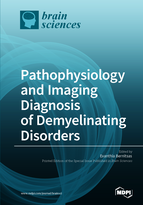Pathophysiology and Imaging Diagnosis of Demyelinating Disorders
A special issue of Brain Sciences (ISSN 2076-3425).
Deadline for manuscript submissions: closed (30 April 2017) | Viewed by 85403
Special Issue Editor
Interests: neuroimmunology; cognition; fatigue; neuroimaging
Special Issues, Collections and Topics in MDPI journals
Special Issue Information
Dear Colleagues,
Demyelinating disorders are chronic autoimmune disorders characterized by inflammation, demyelination, axonal degeneration, and neuronal loss. They have complex pathophysiology and diverse clinical presentations. The etiology of these disorders lies in the interaction between genetic and environmental factors. Due to the complexity in pathophysiology and presentation, diagnosis and treatment can be challenging. Advanced technology, including modern imaging techniques, as well as optical coherence tomography (OCT), enrich our understanding of the disease process, improve diagnostic accuracy, and may guide treatment decisions.
In this Special Issue, we invite and welcome manuscripts addressing, but not limited to: Genetics, etiology, pathogenesis, differential diagnosis, brain imaging, OCT, therapeutics, biomarkers related to disability progression, and critical reviews of clinical trials. Of greatest interest are articles focusing on: (1) advanced MRI imaging modalities and OCT in the differential diagnosis and treatment decisions. (2) novel agents treating symptoms, relapses, and promoting axonal/myelin repair.
We kindly invite you to contribute a manuscript to this Special Issue of Brain Sciences.
Evanthia Bernitsas, MD
Guest Editor
Manuscript Submission Information
Manuscripts should be submitted online at www.mdpi.com by registering and logging in to this website. Once you are registered, click here to go to the submission form. Manuscripts can be submitted until the deadline. All submissions that pass pre-check are peer-reviewed. Accepted papers will be published continuously in the journal (as soon as accepted) and will be listed together on the special issue website. Research articles, review articles as well as short communications are invited. For planned papers, a title and short abstract (about 100 words) can be sent to the Editorial Office for announcement on this website.
Submitted manuscripts should not have been published previously, nor be under consideration for publication elsewhere (except conference proceedings papers). All manuscripts are thoroughly refereed through a single-blind peer-review process. A guide for authors and other relevant information for submission of manuscripts is available on the Instructions for Authors page. Brain Sciences is an international peer-reviewed open access monthly journal published by MDPI.
Please visit the Instructions for Authors page before submitting a manuscript. The Article Processing Charge (APC) for publication in this open access journal is 2200 CHF (Swiss Francs). Submitted papers should be well formatted and use good English. Authors may use MDPI's English editing service prior to publication or during author revisions.
Keywords
- demyelinating disorders
- multiple sclerosis
- therapeutics
- neuroimaging
- optical coherence tomography
- autoimmune
- remyelination







